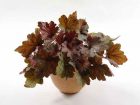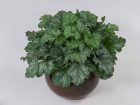
Features
Crop Culture
Inputs
Heuchera Success: a Most Versatile Garden Performer
They offer gardens and containers alike a brilliant splash of colour through their ruffled foliage through to autumn.
October 21, 2015 By Chanochi Zaks
 Kira ‘Autumn Leaves.’
Kira ‘Autumn Leaves.’ November 2015 — Once relegated to a mere light spot in shade gardens, heuchera has become one of the world’s most popular garden plants, establishing itself firmly as a garden classic thanks to a recent resurgence in selection and breeding. The latest efforts have brightened the market with a palette of hues previously unseen in the coral bells world.
No longer just for full to partial shade, heucheras begin bearing clusters of small blooms in late spring, and offer gardens and containers alike a splash of colour through their ruffled foliage right on through autumn.
Series like Kira have a magnificent, wide range of leaf colours with a beautiful mounded
habit. The varieties are heat and drought tolerant, although they will look their best in moderate sun or partial shade. They are ideal for pots, as ground covers, near patios and in mixed containers.
Today’s heuchera palette boasts artistic expressions such as dark veined silver leaves and contrasting red undersides, deep green, silver-overlaid leaves with wine undersides, apricot and peach tones with coppery undersides, vivid green veins on silver and burgundy leaves, purple-red that boast green veins with age, and red-orange leaves that mature to green.
Continuous blooming from springtime on, offers the added promise of hummingbird attraction, and the newest varieties offer long lives and hardiness to USDA Zone 4.
CULTURAL REQUIREMENTS
Production Time: For a 10 cm (four-inch) pot, use one plant per container. Plants will be ready for sale (from rooted cutting) in 12 to 15 weeks. For a 15 cm (six-inch) pot, use one to two plants per pot. Plants will be ready for sale in 12 to 15 weeks. (All times dependent on growing temperature.)
Rooting: Rooting will take approximately six weeks at temperatures of 22 to 23 C (72 to 74 F). Maintain pH at 5.8 to 6.2 and electrical conductivity (EC) at 0.80 for Week 1, 0.80 to 0.90 for Week 2, and 0.90 to 1.0 for Weeks 3 and 4. A 50 ppm nitrogen mist is beneficial. Drench with a broad spectrum fungicide to prevent disease activity, once on the day of sticking and once during Week 2. Mist only when needed. Keep plants on the dry side. A plastic tent may be used.
Medium: Use a well-drained disease-free potting mix. Maintain pH at 5.8 to 6.2 and electrical conductivity (EC) at 0.90 to 1.0.
Pinching: Not necessary for heuchera and heucherella.
Growth regulators: We can consider the use of growth regulators on heuchera as optional. Under high light intensities, it will not be necessary.
Light: Provide supplemental light only. Heuchera prefer full sun or partial shade, approximately 50,000 LUX (5,000 foot candles).
Temperature: Grow at 15 to 18 C or outdoors, when growing in partial shade, it can tolerate a higher temperature. In winter, indoors frost free at 3 to 5 C or outdoors. In spring, the plants start to grow for nine to 12 weeks at 10 to 18 C. Warm temperatures will decrease the cultivation time. Plants may be grown colder if desired.
Vernalization: Most varieties need vernalization for successful production. But varieties like Kira need no vernalization, spontaneously blooming from early February until August in the early Israeli spring. Additional blooms can come in more flowering flushes. Larger containers mean longer bloom times and bigger flower shows.
Nutrition: High fertilization levels are required. Fertilize the crop weekly with 130 to 150 ppm nitrogen (at 3 kg/m³ slow release fertilizer in substrate). Avoid high ammonium and high nitrogen levels. Don’t fertilize after mid-September.
Water: Keep moist, but not over watered, to prevent root damage. Heuchera are best maintained on the dry side, but avoid drying out, as it will cause malformed crops and leaf yellowing. Leach periodically to prevent salt accumulation.
Pest control: Maintaining moderate humidity levels and providing good air circulation should be part of any good preventive program.
Preventing insect or disease activity starts with vigilant scouting and monitoring. Heuchera have few pests and diseases. Plants that are too moist and shady may get some fungus problems during the summer. Moving them to a different site should solve this.
The worst insect pest of the Heuchera-Tiarella group is the Black Vine Weevil, Otiorhynchus sulcatus.
Chanochi Zaks is vice-president of marketing for Danziger “Dan” Flower Farm. • chanochi@danziger.co.il
Print this page

